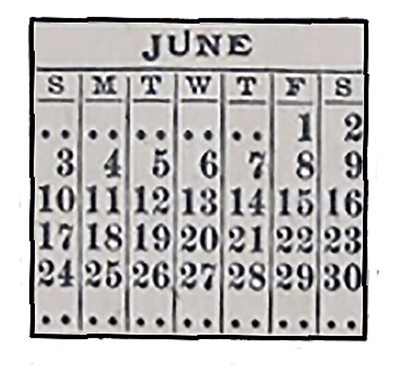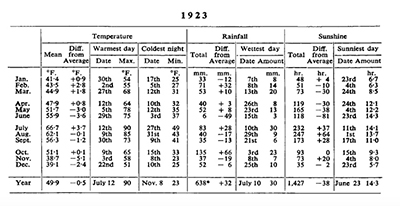Similar to James Joyce’s Ulysses, the events of Virginia Woolf’ Mrs Dalloway take place over the timespan of a single day. In his novel, Joyce is very explicit about the date of Bloomsday: the 16th of June 1904. In Mrs Dalloway, Virginia Woolf is less precise. However, by piecing together evidence from the book, it is possible to hone in on a fairly precise date.
At the end of the fifth paragraph of the novel, we are told two key pieces of information: “…London, this moment of June.” Place and month. We’re already cooking. Reading on one sentence further and we gain more details: “For it was the middle of June.” This sounds promising but, as will be discovered, this ‘middle’ is to become a very contentious word.
However, just over halfway through the novel, a half-awake Lady Bruton lets slip another vital piece of information: “Ah dear, she remembered – it was Wednesday in Brook Street.”
So, the book is set on a Wednesday in mid-June. But what year? Here, there are two clues, both supplied by Peter Walsh. Recalling his absence from London in India he talks about: “Those five years – 1918 to 1923 – had been, he suspected, somehow very important.” And then again, later in the book, and reminiscing about an event from the previous year, he states: “…remember him as he was in August 1922, like a figure standing at the cross roads at dusk…” Taken together, it can be said with some confidence that Mrs Dalloway is set in 1923.
So, a Wednesday in mid-June in 1923. The issue of date seems pretty much sorted, but then we return to that problematic ‘middle’.

The middle of June – a month of 30 days – would suggest the 15th but, in 1923, the 15th of June fell on a Friday. The nearest Wednesday to this date is the 13th of June, and this date has been put forward as Dallowday by both Woolf scholar Harvena Richter and by American literary critic Elaine Showalter. And there is an additional factor, which would appear to support this date: the weather.
Throughout, Mrs Dalloway, there are numerous references to the hot weather – “…splendid morning…”; “It was the heat wave presumably…”; “Long streamers of sunlight…”; “…the day… had exhausted him with its heat…” All rather odd, in fact, given that the Meteorological Office’s general summary of the weather for June 1923 was: “Cool, dull and dry.” Sounds rather like the Met. Office fancies itself as something of a literary critic.

Looking at the weather data more closely, the first half of June 1923 appeared to be cold and wet – the 3rd being the coldest day; the 15th being the wettest – whilst an improvement in conditions occurred towards the end of the month, with the 23rd being the sunniest day, and the 29th the warmest, the mercury on that particular date reaching 25°C. Not bad for pre-global warming. On first glance, this information would not seem to support the idea of Dallowday falling on the 13th of June, but looking at the specific details for the 13th and it appears to buck the general trend for that month.
After a run of cool days and very cold nights at the start of June 1923, on the 10th of June the temperature suddenly rose to a maximum of 20.6°C with seven hours of sunshine. This pleasant spell continued for the next three days, with a peak temperature of 22.2°C and eight hours of sunshine recorded on Wednesday 13th of June. What might be described as a “…heat wave…” given the poor weather that had gone before it. Compare this, too, with the weather on the following Wednesday, the 20th June: a maximum temperature of 16.1°C and a measly 1.1 hours of sunshine. Surely not conditions, which could ever have “…exhausted him with its heat…”?
But, if Wednesday the 20th of June 1923 seems like a non-starter for Dallowday on account of the weather, it does have another factor supporting it as a possible candidate: the sport.
Still falling within the realms of that nebulous ‘middle’, being only three days more off-centre than the 13th, the 20th of June has many supporters who advocate that particular day as Dallowday, among them Morris Beja, Academy Professor Emeritus at The Ohio State University, and most of the reasons that these supporters cite for their belief is based around the evidence of the various sporting events that are referenced in Mrs Dalloway.
In only the sixth paragraph – home of that problematic ‘middle’ – Clarissa Dalloway muses about “…a stirring of galloping ponies, tapping of cricket bats; Lord’s, Ascot, Ranelagh…”
In 1923, Middlesex County Cricket Club played Lancashire at Lord’s from the 16th to the 19th of June, Lancashire easily winning by an innings and 17 runs. Starting on the 19th of June and running until the 22nd of June was the Royal Ascot horse racing festival, with the famous Gold Cup race taking place on the 21st. Both these occasions could easily have been on someone’s mind on the 20th of June. Ranelagh? The annual women’s golf tournament at Ranelagh took place in April 1923. Something of an anomaly. However, slightly later in her musings, when Clarissa returns to these same thoughts, she replaces ‘Ranelagh’ with ‘Hurlingham’: “…Lord’s, Ascot, Hurlingham…” And, here at Hurlingham, there would have been polo played throughout much of the summer.
So far so good for the 20th of June, but there is an additional cricketing reference later on in the novel, which also ties in with this date being a sound contender for Dallowday.
“Surrey was all out” is what the newspaper had said in Mrs Dalloway. And, over the days of 16th, 18th, and 19th of June 1923, Surrey played a three-day match against Yorkshire in the County Championships at Bramall Lane, Sheffield, which Yorkshire won by 25 runs, with Surrey being bowled out in their second innings for a score of 158. A result, which could quite legitimately have been reported in the newspapers on the 20th of June.

Later in the novel, this match is referenced again: “…he felt for a copper to buy a paper and read about Surrey and Yorkshire; he had held out that copper millions of times – Surrey was all out once more…”
Surely this very specific reference to Surrey and Yorkshire knocks the idea of the 13th of June 1923 being Dallowday into the long grass? The Surrey versus Yorkshire match had not been played by that date.
So, 20th June it is. Or is it? David Bradshaw, editor of the Oxford World’s Classic edition of Mrs Dalloway is not so sure. He introduces a third possibility: that the novel is set on a purely imaginary Wednesday in mid-June 1923, not tied to any real-life circumstances. This would explain the problem of the sporting events in the case of the 13th June, and the problem of the weather in the case of the 20th June.
So, Dallowday. The 13th of June 1923. The 20th of June 1923. Or neither of these dates. Chuck them all into the “feathered yellow” hat and take your choice.
© Fergus Longfellow

Fergus Longfellow celebrates Dallowday, whichever date it falls on.
